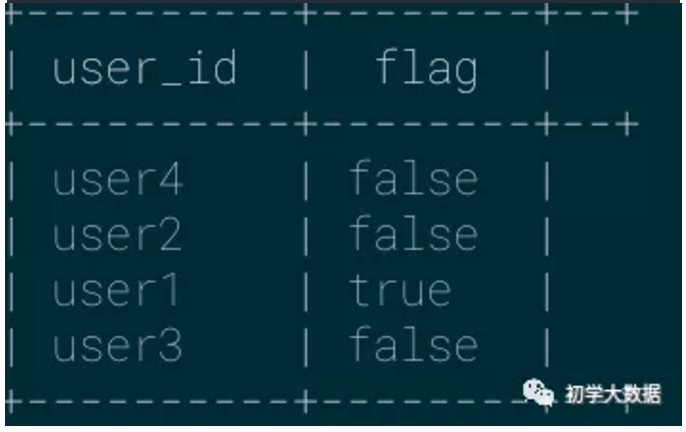条件判断
if:使用频率 ★★★★★
if(boolean testCondition, T valueTrue, T valueFalseOrNull):判断函数,很简单
如果testCondition 为true就返回valueTrue,否则返回valueFalseOrNull
1 --判断是否为user1用户
2 select
3 distinct user_id,
4 if(user_id='user1',true,false) as flag
5 from wedw_tmp.tmp_url_info

case when :使用频率 ★★★★★
CASE a WHEN b THEN c [WHEN d THEN e] [ELSE f] END
如果a=b就返回c,a=d就返回e,否则返回f 如CASE 4 WHEN 5 THEN 5 WHEN 4 THEN 4 ELSE 3 END 将返回4
相比if,个人更倾向于使用case when
1 --仍然以if上面的列子
2 select
3 distinct user_id,
4 case when user_id='user1' then 'true'
5 when user_id='user2' then 'test'
6 else 'false' end as flag
7 from wedw_tmp.tmp_url_info

coalesce:使用频率 ★★★★★
COALESCE(T v1, T v2, …)
返回第一非null的值,如果全部都为NULL就返回NULL
1--该函数结合lead或者lag更容易贴近实际业务需求,这里使用lead,并取后3行的值作为当前行值
2 select
3 user_id,
4 visit_time,
5 rank,
6 lead_time,
7 coalesce(visit_time,lead_time) as has_time
8 from
9(
10 select
11 user_id,
12 visit_time,
13 visit_cnt,
14 row_number() over(partition by user_id order by visit_date desc) as rank,
15 lead(visit_time,3) over(partition by user_id order by visit_date desc) as lead_time
16 from wedw_tmp.tmp_url_info
17 order by user_id
18 )t

数值相关
round:使用频率 ★★
round(DOUBLE a):返回对a四舍五入的BIGINT值,
round(DOUBLE a, INT d):返回DOUBLE型d的保留n位小数的DOUBLW型的近似值
该函数没什么可以讲解的
1select round(4/3),round(4/3,2);
2+------+-------+--+
3| _c0 | _c1 |
4+------+-------+--+
5| 1.0 | 1.33 |
6+------+-------+--+
ceil:使用频率 ★★★
ceil(DOUBLE a), ceiling(DOUBLE a)
求其不小于小给定实数的最小整数;向上取整
1 select ceil(4/3),ceiling(4/3)

floor:使用频率 ★★★
floor(DOUBLE a):向下取整''
1 select floor(4/3);

hex:使用频率 ★
hex(BIGINT a)/ hex(STRING a)/ hex(BINARY a)
计算十六进制a的STRING类型,如果a为STRING类型就转换成字符相对应的十六进制
该函数很少使用,主要是因为曾经遇到过关于emoj表情符脏数据,故使用该函数进行处理
时间相关(比较简单)
from_unxitime:使用频率 ★★★★★
from_unixtime(bigint unixtime[, string format])
将时间的秒值转换成format格式(format可为“yyyy-MM-dd hh:mm:ss”,“yyyy-MM-dd hh”,“yyyy-MM-dd hh:mm”等等)
1select
2 unix_timestamp() as current_timestamp,--获取当前时间戳
3 unix_timestamp('2020-09-01 12:03:22') as speical_timestamp,--指定时间对于的时间戳
4 from_unixtime(unix_timestamp(),'yyyy-MM-dd') as current_date --获取当前日期

to_date:使用频率 ★★★★★
to_date(string timestamp)
返回时间字符串的日期部分
1--最后得到2020-09-10
2select to_date('2020-09-10 10:31:31')
year:使用频率 ★★★★★
year(string date)
返回时间字符串的年份部分
1--最后得到2020
2select year('2020-09-02')
month:使用频率 ★★★★★
month(string date)
返回时间字符串的月份部分
1 --最后得到09
2 select month('2020-09-10')
day:使用频率 ★★★★★
day(string date)
返回时间字符串的天
1 --最后得到10
2 select day('2002-09-10')
date_add:使用频率 ★★★★★
date_add(string startdate, int days)
从开始时间startdate加上days
1 --获取当前时间下未来一周的时间
2 select date_add(now(),7)
3 --获取上周的时间
4 select date_add(now(),-7)
date_sub:使用频率 ★★★★★
date_sub(string startdate, int days)
从开始时间startdate减去days
1 --获取当前时间下未来一周的时间
2 select date_sub(now(),-7)
3 --获取上周的时间
4 select date_sub(now(),7)